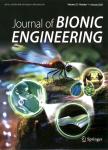Anthropomorphic Control of a Dexterous Artificial Hand via Task Dependent Temporally Synchronized Synergies
Anthropomorphic Control of a Dexterous Artificial Hand via Task Dependent Temporally Synchronized Synergies作者机构:Department of Mechanical Engineering University of Akron Akron OH 44325 USA Department of Biomedical Engineering University of Akron Akron OH 44325 USA
出 版 物:《Journal of Bionic Engineering》 (仿生工程学报(英文版))
年 卷 期:2014年第11卷第2期
页 面:236-248页
核心收录:
学科分类:12[管理学] 1201[管理学-管理科学与工程(可授管理学、工学学位)] 08[工学] 0835[工学-软件工程] 0802[工学-机械工程] 080201[工学-机械制造及其自动化]
主 题:electromyogram dexterous hands grasp synergy prosthetics sliding mode control
摘 要:Despite the recent influx of increasingly dexterous prostheses, there remains a lack of sufficiently intuitive control methods to fully utilize this dexterity. As a solution to this problem, a control framework is proposed which allows the control of an arbitrary number of Degrees of Freedom (DOF) through a single electromyogram (EMG) control input. Initially, the joint motions of nine test subjects were recorded while grasping and catching a cylinder. Inherent differences emerged depending upon whether the cylinder was grasped or caught. These data were used to form a distinct synergy for each task, described as the families of parametric functions of time that share a mutual time vector. These two Temporally Synchronized Synergies (TSS) were derived to reflect the task dependent control strategies adopted by the initial participants. These synergies were then mapped to a dexterous artificial hand that was subsequently controlled by two subjects with transradial amputations. The EMG signals from these subjects were used to replace the time vector shared by the synergies, enabling the subjects to perform both tasks with a dexterous artificial hand using only a single EMG input. After a ten minute training period, the subjects learned to use the dexterous artificial hand to grasp and catch the cylinder with 100.0% and 65.0% average success rates, respectively.




